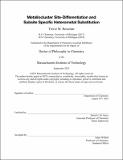Metallocluster Site-Differentiation and Subsite Specific Heterometal Substitution
Author(s)
Bostelaar, Trever M.
DownloadThesis PDF (13.90Mb)
Advisor
Suess, Daniel L. M.
Terms of use
Metadata
Show full item recordAbstract
The deployment of metalloclusters in applications such as catalysis and materials synthesis requires robust methods for site-differentiation: the conversion of clusters with symmetric ligand spheres to those with unsymmetrical ligand spheres. However, imparting precise patterns of site-differentiation is challenging because, compared with mononuclear complexes, the ligands bound to clusters exert limited spatial and electronic influence on one another. In Chapter 2, we described a method that used sterically encumbering ligands to bind to only a subset of a cluster’s coordination sites. Specifically, we showed that homoleptic, phosphine-ligated Fe–S clusters undergo ligand substitution with N-heterocyclic carbenes to give heteroleptic clusters in which the resultant clusters’ site-differentiation patterns are encoded by the steric profile of the incoming N-heterocyclic carbene. This method afforded access to every site-differentiation pattern for cuboidal [Fe₄S₄] clusters and was extended to other cluster types in Chapter 3, particularly in the stereoselective synthesis of site-differentiated Chevrel-type [Fe₆S₈] clusters. In Chapter 4, we further utilized the 3:1 site-differentiation of cuboidal [M₄S₄] (M = Fe or Co) clusters to perform subsite specific metal atom substitution at each cluster. Specifically, we showed that the unique metal sites of homometallic clusters of the form [M₄S₄(IMes)₃Cl]+ can be selectively excised by addition of 2 equiv TlTp. Reconstitution with M′Cl2 (M′ = Co, Fe, for M = Fe, Co, respectively) yielded the heterometallic clusters [CoFe₃S₄(IMes)₃Cl]+ and [FeCo₃S₄(IMes)₃Cl]+. The reduced clusters, [M′M₃S₄(IMes)₃Cl], as well as the CO-bound clusters, [M′M₃S₄(IMes)₃(CO)], were also prepared, and a comparative analysis of the properties of all three series of clusters was undertaken. Low-valent electronic configurations are accessed in all four clusters, [Fe₄S₄(IMes)₃(CO)], [CoFe₃S₄(IMes)₃(CO)], [Co₄S₄(IMes)₃(CO)], and [FeCo₃S₄(IMes)₃(CO)], and this studied further reveals how heterometal substitution modulates the degree of C–O bond weakening.
Date issued
2023-09Department
Massachusetts Institute of Technology. Department of ChemistryPublisher
Massachusetts Institute of Technology